BY Tom Ewing and Gina Smith
aNewDomain News — Earlier this week The Los Angeles Times announced it was firing Pulitzer Prize-nominated political cartoonist and essayist Ted Rall because the Los Angeles Police Department accused Rall of lying about what happened during a ticketing for jaywalking 14 years ago.
Turns out the police and the Times dead wrong.
An examination of the “evidence” by audio engineers hired by Ted Rall and aNewDomain shows the LAPD’s and Times’ allegations against Rall to be false. Click here to listen to the new tape.
Hard questions now loom for the LAPD and the Times. As whistleblowers, journalists and the legal community begin their investigations, let’s examine some of the main issues they’ll be scrutinizing.
 What we know so far:
What we know so far:
The controversy began shortly after the Times published a May 2015 column where Rall (pictured) took the LAPD to task for its latest pedestrian crosswalk crackdown.
In the column, Rall recounted his own 2001 arrest for jaywalking on LA’s Melrose Avenue. Rall wrote that the arresting officer shoved him, cuffed him and tossed his driver’s license into the gutter, as a crowd of protesting onlookers gathered around.
After the column was published, the pressure on the columnist began.
Editors told Rall that the LAPD approached the Times first, claiming that Rall’s allegations about being handcuffed were just plain untrue. As proof, the LAPD furnished the Times with a 14-year-old tape of the incident to prove Rall was lying about the stop, the officer’s poor treatment of him, even the crowd that protested. (Listen to that version of the tape below the fold, or here.)
The LAPD maintaine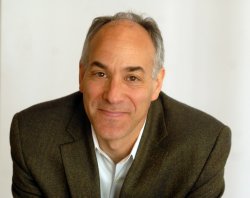 d the officer remained polite and professional throughout the incident. It claimed to the Times that Rall was never mistreated and that nobody rushed to his defense.
d the officer remained polite and professional throughout the incident. It claimed to the Times that Rall was never mistreated and that nobody rushed to his defense.
But the audio evidence cops furnished the Times was mostly inaudible. Some polite conversation at the beginning and end of the ticketing stop can be heard on that tape, but the rest of it was of exceedingly poor quality. That first tape contained 20 seconds of talk — and fully six minutes of static and unintelligible noise.
Yet editors of the Times agreed with the LAPD based on the mostly inaudible tape. The Times fired Rall on July 26, 2015 and the next day it went public with the news. In a formal note to readers, Times editor Nick Goldberg (pictured) questioned Rall’s integrity, explained the discrepancies between the cops’ story, the tape and what Rall has published in the paper. And it severed all ties with him.
Here’s an excerpt from Goldberg’s Editor’s Note:
An audiotape of the encounter recorded by the police officer does not back up Rall’s assertions; it gives no indication that there was physical violence of any sort by the policeman or that Rall’s license was thrown into the sewer or that he was handcuffed. Nor is there any evidence on the recording of a crowd of shouting onlookers … In Rall’s initial complaint to the LAPD, he describes the incident without mentioning any physical violence or handcuffing but says that the police officer was ‘belligerent and hostile’ and that he threw Rall’s license into the ‘gutter.’ The tape depicts a polite interaction.”
Neither Goldberg, nor reporter Paul Pringle, who was deputized to investigate Rall, moved to analyze the tape for further information. Goldberg and Pringle have not responded to repeated requests for comment.
UPDATE: August 6, 2015: Goldberg today returned an email asking for comments by Gina Smith, saying he “can’t” comment.
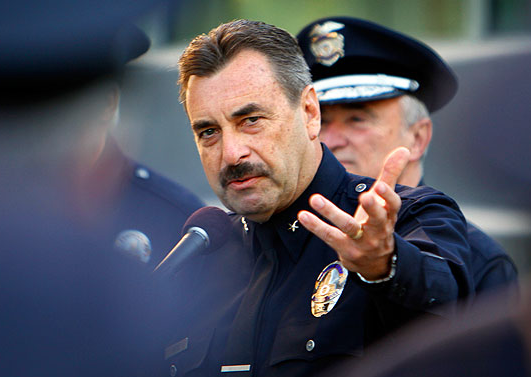 Pringle told Rall that the Times knew the LAPD tape was authentic because, he said, the LAPD had vouched for its authenticity.
Pringle told Rall that the Times knew the LAPD tape was authentic because, he said, the LAPD had vouched for its authenticity.
Such an accusation requires a rigorous examination before being accepted, especially when two parties clearly have a history of butting heads.
Rall’s cartoons had been a source of irritation to the the LAPD, all the way up to LAPD Chief Charlie Beck. The Los Angeles Police Protective League (LAPPL) said as much in an exultory post it put up at LAPD.com that said as much.
It took only three days for Rall to get the tape examined and significantly improve its audio quality. Any journalist could have found an audio engineer and conducted such basic fact-checking.
Neither the LAPD nor the Times took the time to examine the evidence with thorough science.
The enhanced tape, released by Rall and aNewDomain Friday, provides a more complete picture of what happened that day on Melrose Avenue. Listen here or scroll below the fold for a comparison of both tapes. A little over three minutes in, an onlooker can clearly be heard loudly asking the police officer to “take off the handcuffs” — twice. Onlookers also are audible in the background.
Based on this new evidence, at least one Los Angeles opinion maker has formally called for the LAPD Office of the Inspector General to launch an investigation into the firing.
Why would the LAPD go after Ted Rall?
Ted Rall was a thorn in the LAPD’s side. The political cartoonist had been critical of the department and its policies since 2009 when the LA Times hired him.
 The LAPD has not responded to requests for comment on the firing or the independent examination of their audio file.
The LAPD has not responded to requests for comment on the firing or the independent examination of their audio file.
But the Los Angeles Police Protective League — the police officers’ union — published a congratulatory post on the LAPD.com that celebrated the firing. The post begins:
So many within the LAPD were pleasantly surprised at the recent firing of Los Angeles Times opinion cartoonist Ted Rall, which we believe was justified based on evidence proving that he lied about his encounter with LAPD officers. We especially appreciate the Times’ reaction, as the media in general often seems eager to publish material portraying law enforcement in a negative light.”
The post goes on to congratulate the editors of the Los Angeles Times:
We commend the Los Angeles Times for getting this story right, and for doing the right thing when presented with the facts.”
The police union blog also issued this warning to other news media:
We hope other news publications will take note of the Times’ willingness to hear and respond to the other side of the story and look at the facts. We believe this process, more often than not, will vindicate law enforcement officers.”
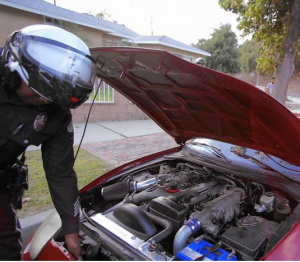
The LAPD maintains that its officer acted with polite professionalism and that Rall lied when he described the officer’s rough treatment of him.
Rall says he was told while being questioned by Times reporter Paul Pringle that the LAPD officer who stopped Rall had never handcuffed Rall or anyone else.
But a quick Internet search revealed that the Times published a story on May 10 — “LAPD trying to put the brakes on illegal street racing.” The story mentions the same LAPD officer (pictured above) who stopped Rall and reports the police officer handcuffing a driver at a traffic stop.
Why didn’t the journalists at the Times find this evidence from their own newspaper before leveling another unfounded accusation against one of their columnists?
Why did the LAPD make such an exaggerated claim which its own records could have easily disproved?
Read more about discrepancies in the LAPD’s story about Rall here.
Did the LAPD take down Rall for a reason?
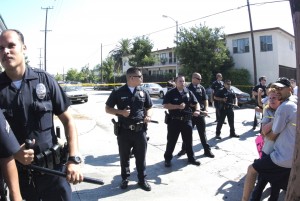 The LAPD’s latest actions call into question whether it has engaged in a pattern of intimidation toward the media.
The LAPD’s latest actions call into question whether it has engaged in a pattern of intimidation toward the media.
Other LAPD patterns of abuse have already been historically established.
After a series of LAPD civil rights violations the United States Department of Justice basically had to run the department from 2001 to 2009.
The LAPD has historically been insular, bunker-minded and extraordinarily unwilling to admit mistakes, according to the Christopher Commission. Former U.S. Secretary of State Warren Christopher led that commission after the LAPD Rodney King beating in 1991.
In the LAPD Rampart scandal of the late 1990s — which has been called one of the worst and most widespread cases of documented police misconduct in U.S. history — 70 LAPD officers were convicted of unprovoked shootings, unprovoked beatings, planting of false evidence, frame-ups, stealing, dealing narcotics, bank robbery, perjury and the covering up of evidence of these activities.
A later investigation and analysis of the Rampart scandal concluded:
The LAPD instinct is to shut out all outsiders and to adopt a ‘siege mentality,’ which justifies excluding those who are not a part of the department from evaluating or criticizing it. The siege mentality is so integral to the LAPD that the Christopher Commission found LAPD field training officers openly teaching it to new officers. Reasonable degrees of internal reliance and separation from outsiders are expected in police departments. However, LAPD’s peculiar insularity is coupled with hostility and considered extreme.”
The report went on to quote Former LAPD Chief Bayan Lewis, who admitted:
All police departments tend to be inward-looking, but LAPD is worse than anybody. It’s us against the world. We see ourselves as the last bastion of good people in a world that’s crumbling.”
Why is the LAPD spending taxpayer money and time?
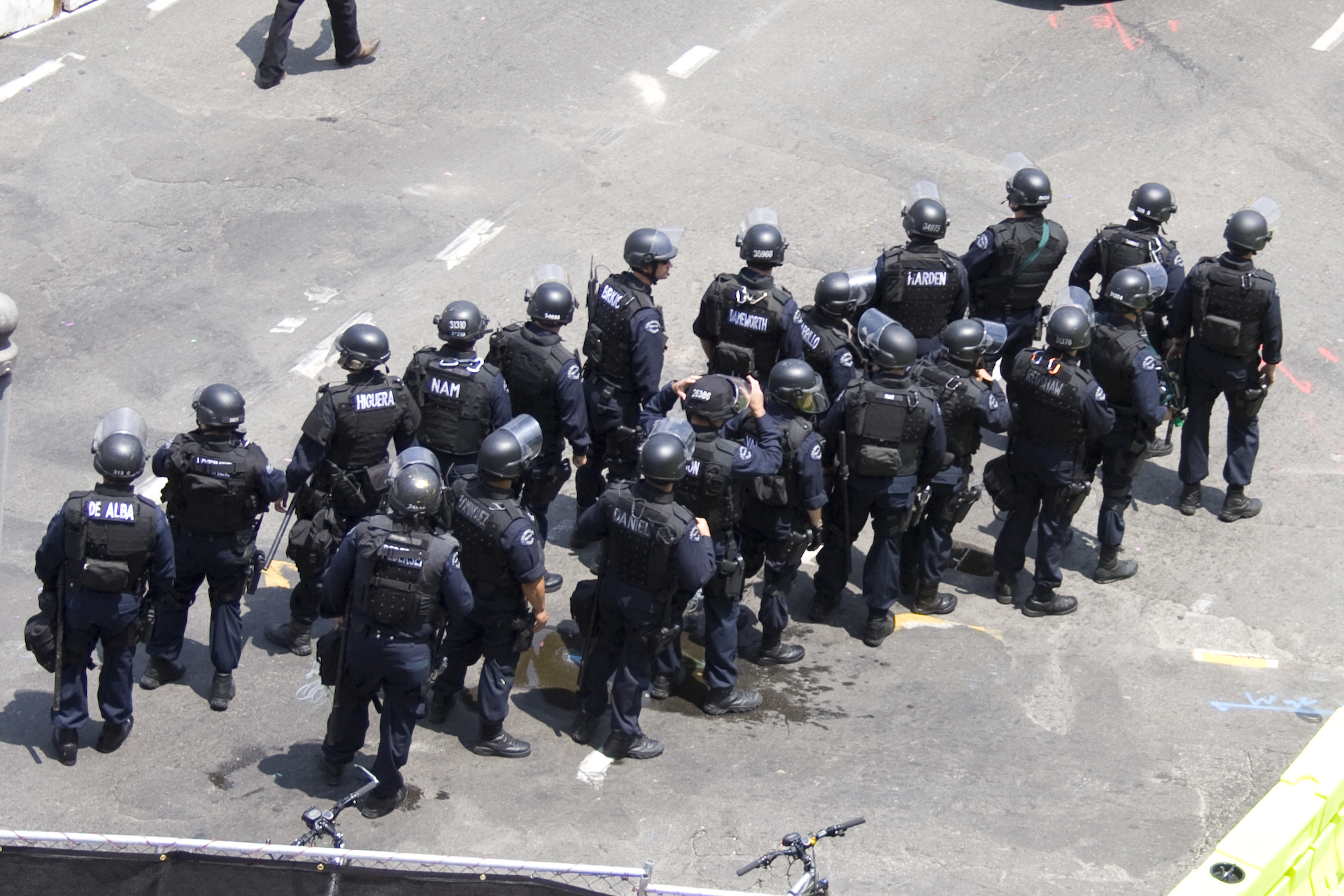 In Rall’s original post about the Times’ firing, Rall wondered why the LAPD spent taxpayer money and time to find and transcribe a 14-year-old tape about a jaywalking stop.
In Rall’s original post about the Times’ firing, Rall wondered why the LAPD spent taxpayer money and time to find and transcribe a 14-year-old tape about a jaywalking stop.
That’s a great question.
Here’s another good one: Could the use of such questionable evidence to persuade the Times to fire a critical voice indicate that outside forces are in play?
It isn’t as much of a stretch as it sounds. The rich and powerful City of Los Angeles Department of Fire & Police Pension Fund indirectly owns a hunk of the Times‘ parent company, Tribune Publishing.
And a precedent has already been established of that same pension fund working to end the careers of journalists by lobbying as their “owners.”
In 2009 representatives from the LA Fire & Police Fund sent a letter demanding the removal of editors and writers at the San Diego Union-Tribune. The fund managers made it clear in the letter who really owned that newspaper — its debt handler, Beverly Hills Platinum Equity. Not so coincidentally, $30 million of the LA Fire & Police Fund was invested in Platinum at the time.
In the letter penned by LAPPL President Paul Weber to Platinum demanding the firing of the San Diego journalists, he wrote:
Since the very public employees they continually criticize are now their owners, we strongly believe that those who currently run the editorial pages should be replaced.”
In May it was announced that the San Diego Union-Tribune was sold to Tribune Publishing.
Note that the single largest owner of Tribune Publishing is another ultra-wealthy LA investment vehicle, Oaktree Capital. Oaktree manages an estimated $18.4 billion in Los Angeles Fire & Police pension funds.
Was LAPD’s release of the tape to the Times lawful?
How did the LAPD come to give the tape of Rall’s ticketing to the Times in the first place?
Police audio recordings aren’t public records. They have been judicially excluded from public records laws in California for more than a decade.
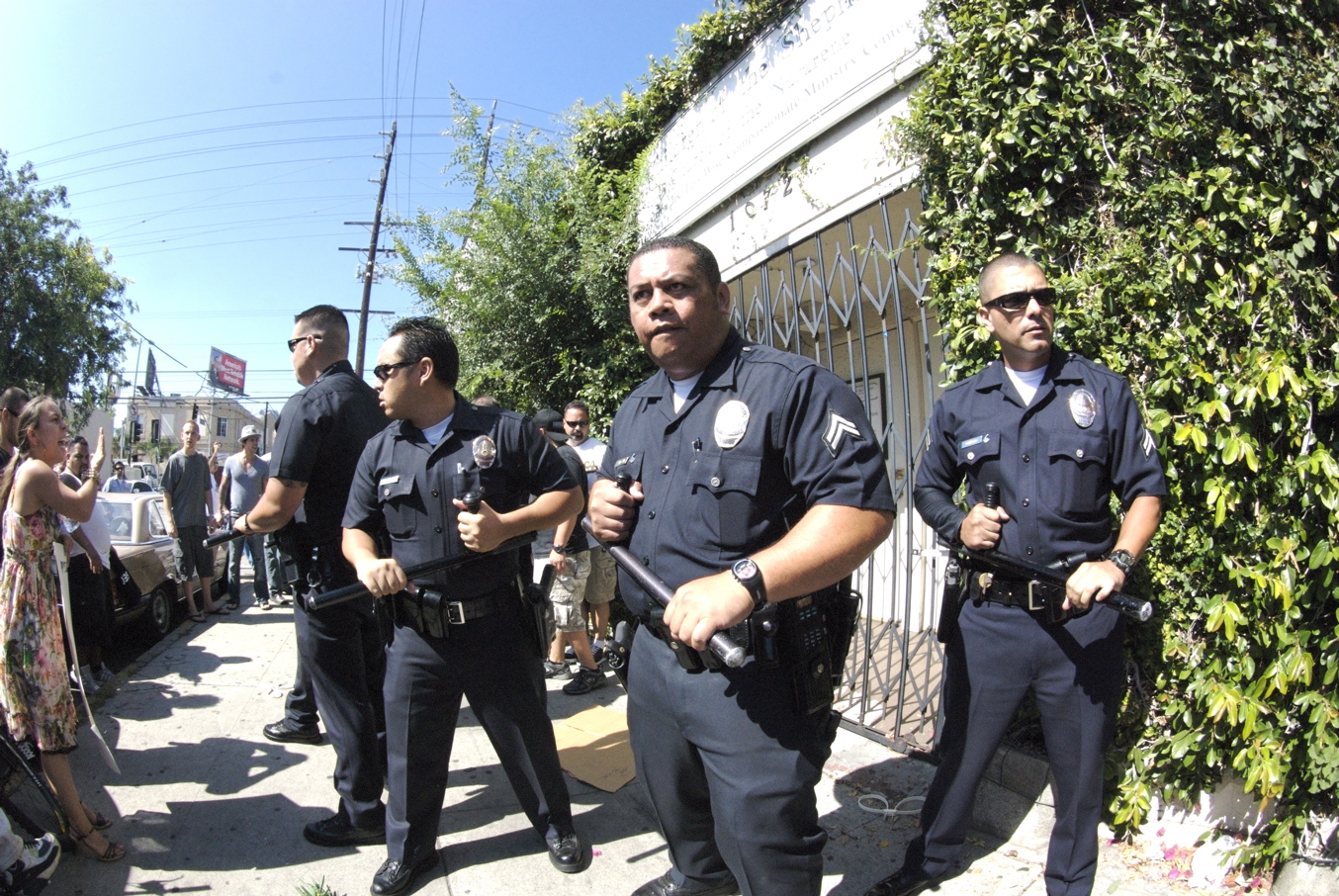
The LAPD’s official policy mirrors the requirements of California Public Records Act, Section 6254(f) and regularly provides arrest reports, charges, statements, bail amounts and other routine information to the media and public.
But the LAPD’s 48-page Media Relations Handbook is silent about whether the department can disclose audio tapes made by police officers while on duty. For good reason: A 2001 California State Supreme Court decision held that such tapes are not public records and do not have to be released.
There are many legal limitations placed on where, when and how you can record someone, especially if you are a public agency recording a private individual.
Was the LAPD breaking the law when it found the audio recording and gave it to the Times? Was the Times required by law to file any documents or inform anyone, like Rall, before trying to access the tape? Was it allowed by law to use such audio against him when firing him?
What does the law say about police recordings and privacy?
Both statutory law and case law in California support the position that an audio tape made by the police is not part of the public record. This raises questions about how much the LAPD and the Times could have done with Rall’s audio tape without notifying Rall that the tape was being disclosed. The Times and the LAPD have not responded to our questions about this.
The California Supreme Court held in Haynie v. Superior Court (County of Los Angeles 2001) that police recordings during a traffic stop are not public records subject to disclosure under the California Public Records Act. In Haynie, a man who had been stopped by police but not arrested had sued Los Angeles County over the actions of the Sheriff’s deputies who stopped him.
The Court held that audio recordings falling under Sec. 6254(f) were not public records.
Rackauckas (2002), a subsequent case, went further. That case held that timing of investigation materials pre-investigation or post-investigation made no difference in a records request. There are likely other nuances to California public records laws, but the combination of Haynie and Rackauckas make clear that police audio recordings are exempt from public records laws.
California public records law seems to prevent Ted Rall from obtaining a copy of such an audio recording. So how could the LAPD be justified in not only obtaining the tape, but giving it to the LA Times for the purpose of discrediting Rall?
This incident also raises questions about the use of public funds for lobbying by the police department. How much of the LAPD’s $1.4 billion budget is allocated to attacking journalists?
Who controls this budget? Who decides which critics the police attack? Who coordinates the attacks?
The U.S. Department of Justice could investigate all of these things.
What is the mission of LAPD Media Relations?
The Los Angeles Police Department’s Media Relations Section says its mission is to “foster cooperation and mutual respect.”
But they wouldn’t return our calls to discuss this or anything else that happened this week.
The LAPD’s behavior calls into question whether there exists a broader pattern of police bullying the media.
Did someone doctor the tape?
So far the audio tape the LAPD used against Rall remains something of a mystery. Rall and aNewDomain are continuing efforts to examine the audio and glean all its secrets.
But this much is clear: Just by whistling during his clandestine recording ticketing stop, the LAPD officer essentially altered the recording. Whether he did so knowingly is still unclear. It is worth noting that the officer whistled into the mic after one of the female bystanders asked him to remove Rall’s cuffs.
Several of the producers who’ve been working with aNewDomain and Rall on the audio enhancements have told us they believe that the police officer seemed to have purposely muffled his recording device, too. The LAPD has not returned repeated requests for comment on this.
On the tape the LAPD gave to the Times, the crowd was inaudible and hidden among the muffling and the static.
In the first version of the enhanced audio Rall and aNewDomain posted, you can begin to hear some of the bystanders’ protests.
In the coming days we will publish more enhanced versions of the recording. Stay tuned.
Are aggressive cops overreacting at traffic infractions?
The LAPD has only recently emerged from being overseen by the U.S. Department of Justice because of egregious civil rights violations. And the LAPD has been extraordinarily unresponsive to civilian complaints. Even when under DOJ supervision, the LAPD claimed just 1.6 percent of the complaints it received about discourteous police officers were justified. A whopping 85 percent of LAPD police officers surveyed in the same report agreed or strongly agreed with the statement “most civilian complaints are frivolous.”
Curtailing media criticism would obviously be helpful to the LAPD’s image problems, especially in the era of Ferguson, Baltimore, and Charleston.
There is significant evidence that the LAPD enforces illegal traffic quotas. In 2011 even some of its own had enough — ten LAPD West Traffic Division officers sued the LAPD, alleging their bosses punished them for not writing enough tickets. These officers were from the same division which named the officer who stopped Rall as the 2006 Officer of the Year.
 Who are the police, anyway?
Who are the police, anyway?
Famed British Admiral Sir Jacky Fisher was known for the phrase, “Hit Hard. Hit First. Keep on Hitting.” That’s a good mantra for the Royal Navy, but perhaps does not serve a modern police department whose motto is “To Protect and to Serve.”
Is it the role of the police in a free society to intimidate American journalists?
It bears remembering that journalists are public servants, too, whose free and unfettered existence is guaranteed by the First Amendment of the United States Constitution. A free society that doesn’t allow and foster free speech in general means the media’s right to free speech never remains free for long. History can provide many examples.
To the degree that the Los Angeles Police Department knowingly attempted to take down Ted Rall with dodgy evidence, and is using this to intimidate other members of the news media, the Ted Rall scandal is worrisome.
Investigators from the LAPD’s Office of the Inspector General and other interested agencies should and no doubt will be looking long and hard at what happened here.
Any informed citizen knows that it’s critical to free speech and justice to follow the law and act with transparency and honesty — not just for journalists, but for all American citizens.
Scroll below for various documents relating to the LAPD, details on the Rampart scandal, audio from the enhanced police tape that vindicated Rall and other relevant content.
For aNewDomain News, this is Tom Ewing and Gina Smith reporting.
Here’s the audio from the police tape dub the Times said cops gave them to prove Rall was lying about getting handcuffed and the presence of protesting onlookers. There are multiple incidents on the tape. Rall’s begins at 6:30. Scroll below for Rall’s and aNewDomain’s enhanced version of the audio. It tells a profoundly different story.
Here’s the enhanced version of the LAPD tape that vindicates Rall, below. You can hear one onlooker protest the officer’s treatment of Rall at 3:30. She repeats her appeal to the LAPD officer a few seconds later, saying loudly, “Take off his handcuffs!”
Analysis of the Rampart Scandal
Harvard LAPD Study During Consent Decree
Update, Aug. 6, 2015: For further reading, check out these links:
Ted Rall-LAPD-LA Times Scandal: Timeline by Gina Smith (aNewDomain)
A Note to Readers (about the Ted Rall firing) by LA Times editor Nick Goldberg (LA Times)
LAPPL Applauds LA Times Firing of Ted Rall (by Los Angeles Police Protective League Board of Directors (LAPD.com)
LAPD Convinced LA Times To Fire Me After I Criticized Cops [exclusive] by Ted Rall (aNewDomain commentary)
Ted Rall, Los Angeles Times Cartoonist, Dropped After Blog Post Appears To Stretch The Truth (FoxNews.com)
Ted Rall LAPD-LA Times Scandal: A Discrepancy In The Cop’s Story [exclusive] by Ted Rall (aNewDomain commentary)
Ted Rall-LAPD-LA Times Battle: New Tape Proves Cops, Times Were Wrong [exclusive] by Gina Smith and Ted Rall (aNewDomain commentary)
Ted Rall LAPD LA Times Scandal: Second Enhanced LAPD Tape Reveals Startling Details [exclusive] by Ted Rall, Gina Smith and Tom Ewing (aNewDomain)
Ted Rall LAPD Scandal: Rall Vindicated, LAPD And LA Times under Fire by Tom Ewing and Gina Smith (aNewDomain news)
Did The LAPD Have A Political Cartoonist Fired? by Ryan Steadman and Guelda Voien (The New York Observer)
‘Cleaned-Up’ Audiotape of Political Cartoonist’s Clash With LAPD Bolsters His Story by Hunter Harris (New York Observer)
In Defense of Ted Rall, A Hard Guy To Defend by Ken Kurson (New York Observer opinion column)
Why Didn’t The Los Angeles Times Examine The Bad Audio from the LAPD? by Ted Rall (aNewDomain commentary)
Cops Gun Down Unarmed Journalist’s Career by Greg Palast (Reader Supported News, opinion)
Ted Rall: Fisking The Los Angeles Times by Ted Rall (aNewDomain commentary)
Why Won’t The L.A. Times Admit They Were Wrong About Cartoonist Ted Rall? by Susie Madrak (Crooks and Liars)
14 Years Ago, A Woman Vindicated Me Now by Ted Rall (Common Dreams)
Cover image: Los Angeles Police officers preparing for Occupy LA, NBCLosAngeles.com, All Rights Reserved.
Nick Goldberg image: ManhattanCountrySchool.com, All Rights Reserved.
Image of generic police officers: By Shay Sowden (https://www.flickr.com/photos/gigaboss/899521441) [CC BY 2.0], via Wikimedia Commons, All Rights Reserved.
Image of LAPD Officer who stopped Ted Rall for jaywalking at a minor traffic infraction in Los Angeles, in which the suspect was handcuffed: LATimes.com, All Rights Reserved.
Image of police officers in riot gear: By J R [CC BY 2.0], via Wikimedia Commons.
Image of police officers fending off hostile crowd: By Shay Sowden (https://www.flickr.com/photos/gigaboss/899561011) [CC BY 2.0], via Wikimedia Commons.
Image of Admiral Sir Jacky Fisher: “Adm. John Fisher” by Bain News Service, publisher – Library of Congress Prints and Photographs Division Washington, D.C. This image is available from the United States Library of Congress‘s Prints and Photographs division under the digital ID ggbain.18059. This tag does not indicate the copyright status of the attached work. A normal copyright tag is still required. See Commons:Licensing for more information. Licensed under Public Domain via Wikimedia Commons.














Yay! I’m so glad that you’re pursuing this story with a sense of righteous indignation!!
I have become obsessed with this chain of events — and I hope Ted Rall is able to obtain justice and a huge monetary judgment or settlement!
Congratulations for first-rate analysis, investigation, and commentary — journalistic elements that sadly are in short supply at today’s L.A. Times.
There needs to be a criminal investigation into who altered the tape to make it misleading.
Forty years ago I blindly supported police authority and would have accepted that Ted Rall was guilty as charged and deserved to be fired. That’s the way I was brought up, respect ‘authority’. However, over the years after getting closer to the inner workings of the local police department it became readily obvious that our community security structure was operating on the “us against them” paradigm. The rationalization for mistreatment of ordinary citizens guilty of low level misdemeanors was “we’re not social workers we enforce the law”. What? The prevailing police mentality was based on them being the “good guys” and everyone else as being the “bad guys” or suspects at least. I finally grew up when I was accosted by capital police while taking photographs of national monuments in DC, my ‘heroes’ suddenly became transparent as I realized that they were indeed willing and capable of assaulting innocent people going about daily activities. After a second baseless encounter my eyes were opened. Policemen are not your friend and they are seldom capable of rational judgment and behavior, they seemed to be operating on different premises than what I was taught. All of this was very disheartening. Shortly after this I became aware of the big picture, bias, prejudice, ignorance and personal short comings dominated by an unspoken political agenda was what motivated my friend the policeman! Rall is gifted with sarcastic insight at an artistic level, his ability to bring attention to glaring inequities of law enforcement is a vital social necessity for waking numb skulls such as myself from the hypnotic haze of social conditioning. Ted’s art provides a safety valve for a system that is no longer self correcting, silencing him is equivalent to sealing the safety valve on a pressure cooker, a big mistake!